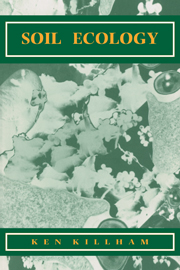Book contents
- Frontmatter
- Dedication
- Contents
- Foreword
- Introduction
- 1 The soil environment
- 2 The soil biota
- 3 Ecological interactions between the soil biota
- 4 The ecology of soil nutrient cycling
- 5 Ecology of extreme soil environments - soil water stress
- 6 Ecology of polluted soils
- 7 Manipulation of soil ecology - ‘soil biotechnology’
- References
- Further reading
- Index
7 - Manipulation of soil ecology - ‘soil biotechnology’
Published online by Cambridge University Press: 12 October 2018
- Frontmatter
- Dedication
- Contents
- Foreword
- Introduction
- 1 The soil environment
- 2 The soil biota
- 3 Ecological interactions between the soil biota
- 4 The ecology of soil nutrient cycling
- 5 Ecology of extreme soil environments - soil water stress
- 6 Ecology of polluted soils
- 7 Manipulation of soil ecology - ‘soil biotechnology’
- References
- Further reading
- Index
Summary
INTRODUCTION
In recent years, a greater understanding of soil ecology has facilitated the emergence of a soil biotechnological revolution where biological components (plants, microbes and animals) of the soil/plant system are manipulated to increase plant (i.e. crop) productivity. These manipulations are increasingly involving genetic change although many can simply involve the selective introduction, control or removal of soil organisms.
The first microbial inoculum to be introduced into agricultural systems as a biofertiliser was almost certainly Rhizobium, the controlled use of rhizobial inocula dating back to the late nineteenth century.
BIOFERTILISATION BY RHIZOBIAL INOCULATION
Potential for inoculation - temperate and tropical agriculture
There are a variety of N2-fixing legumes currently used in temperate agriculture. The ‘grain legumes’ include broad beans (Vicia faba), peas (Pisum sativum), runner and haricot beans (Phaseolus spp.) and lupins (Lupinus spp.). The ‘forage legumes’ include a variety of clovers (Trifolium spp.), lucerne or alfalfa, and medics (Medicago spp.), fenugreek or birdsfoot trefoil (Trifolium ornithopodioides), lotus (Lotus) and vetches (Vicia spp.). For most of these legumes, rhizobial inoculation is not required. Broad beans, for example, fix an average of 200 kg N ha∼x y ” * in the UK (Nutman, 1976) and the nodules generally function satisfactorily without inoculation (Cooper, Hill-Cottingham & Lloyd-Jones, 1976). Lucerne (or alfalfa) on the other hand, however, shows considerable potential for improved fixation/production from rhizobial inoculation.
In tropical agriculture, the potential for improved crop productivity from rhizobial inoculation is generally much higher than for temperate systems. Crops such as soybeans (Glycine max.), peanuts (Arachis hypogea) and mung beans (Vigna radiata) are good examples of tropical legumes that can benefit enormously from rhizobial inoculation.
In general, inoculation will be most effective when the soil's indigenous rhizobia are either ineffective or present in insufficient numbers to provide a reasonable inoculum. An extreme case of this latter problem can be found in Australia where native populations of rhizobia are often completely absent. Similar situations may also exist when previously barren soils, such as in arid areas, are brought into cultivation. These types of situation contrast sharply with temperate agricultural soils, which can have an indigenous rhizobial population of about one hundred thousand per gram.
Rhizobial effectiveness and inoculum production
It is not always clear why a legume planted in some soils is not adequately nodulated by the indigenous soil microbiota.
- Type
- Chapter
- Information
- Soil Ecology , pp. 182 - 211Publisher: Cambridge University PressPrint publication year: 1994

